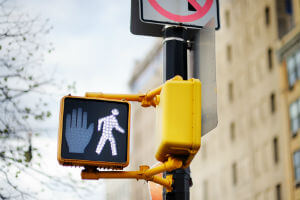Increase in U.S. Pedestrian Deaths Projected for 2016
 The number of pedestrians killed on U.S. roadways is projected to have risen by 11 percent in 2016, compared to 2015.
The number of pedestrians killed on U.S. roadways is projected to have risen by 11 percent in 2016, compared to 2015.
By utilizing preliminary data for the first half of 2016 and considering past trends, the Governors Highway Safety Administration (GHSA) estimates that 5,997 pedestrians were killed last year, compared to 5,376 in 2015 and 4,910 in 2014.
This represents the largest year-to-year increase in pedestrian deaths since record keeping began approximately 40 years ago.
The study comes shortly after the release of estimates from the National Safety Council and the National Highway Traffic Safety Administration showing that total traffic deaths for 2016 increased significantly compared to the previous year.
U.S. Pedestrian Deaths Continue to Increase
Since 2014, the GHSA estimates that pedestrian deaths have increased by 22 percent. Pedestrians now account for the largest proportion of traffic fatalities in the last 25 years.
Furthermore, pedestrian deaths continue to account for a larger percentage of total traffic accidents. The percentage has increased steadily from 11 percent in 2006 to 15 percent in 2015. The GHSA estimates that the percentage will remain at 15 percent for 2016.
If the GHSA estimates are correct, 2016 could mark the first year in more than two decades that the number of pedestrian deaths reached or surpassed 6,000 deaths.
State Percentages Vary
In its 2017 report titled Spotlight on Highway Safety Report, the GHSA found that the number of pedestrian deaths for the first half of 2016 differed significantly between states.
- The report showed that 34 states reported increases in pedestrian fatalities, 15 states and the District of Columbia experienced decreases, and one state (Maine) reported no changes.
- California had the highest number of pedestrian deaths at 359, while Wyoming had just one pedestrian death.
- Four states including California, Florida, New York and Texas accounted for 42 percent of all pedestrian fatalities.
Pedestrian Deaths in California
Preliminary estimates of 359 pedestrian deaths in California during the first six months in 2016 mark an 11.4 percent decrease compared to the 405 fatalities during the same period in 2015.
California’s efforts to reduce pedestrian fatalities throughout the state combine law enforcement campaigns and awareness programs, such as:
- Establishing September as Pedestrian Safety Month
- Funding the printing and distribution of culturally specific educational materials
- Funding and distributing pedestrian safety equipment, including reflective arm and leg bands and crossing guard kits
- Collaborating with community organizations, law enforcement, traffic safety advocates, hospitals and schools
California’s law enforcement efforts include targeting primary collision factors and conducting crosswalk stings and distracted driving operations at areas with high numbers of pedestrian-related collisions.
Cause of the Increase
The GHSA believes several factors may have contributed to the spike in pedestrian deaths, including increases in the number of people choosing to travel by foot and an improved economy, which increased the number of vehicle miles traveled in 2016.
Another potential cause for the spike is the use of smartphones and portable electronic devices. The GHSA stated that this has been a particularly troubling trend that causes serious distractions for both drivers and pedestrians.
Help for Pedestrian-Auto Accidents
As the number of pedestrian and auto accident-related fatalities continues to increase, it is important that everyone sharing the road disengage from distracting activity and dangerous behavior.
If you have been injured or lost a loved one in a pedestrian-auto accident, you may have options that allow you to take legal action.
Do not hesitate to contact a Sacramento injury lawyer from the Arnold Law Firm for a free consultation to discuss your claim and the circumstances surrounding your injury. There is no obligation to hire our firm and we charge you no upfront fees. Our contingency fee basis means that you only pay us if we help you recover compensation for your claim.
Fill out a Free Case Evaluation form to get started today.
